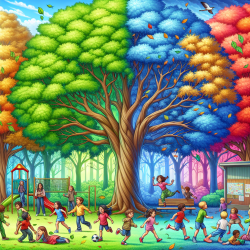Unlocking the Power of Seasonal Foliage in Schoolyards
As a passionate advocate for data-driven approaches in speech-language pathology, I am thrilled to share insights from a fascinating study titled "Orange Is the New Green: Exploring the Restorative Capacity of Seasonal Foliage in Schoolyard Trees." This research provides valuable guidance for practitioners looking to enhance children's learning environments through strategic schoolyard greening.
The Study's Key Findings
The study, conducted in a school in London, Ontario, Canada, explored how different seasonal foliage in schoolyards impacts children's perception of restorative environments. Using digital visualization models, researchers found that seasonal changes in tree foliage significantly influence the perceived restorative quality of schoolyards.
- Fall Foliage: Surprisingly, fall foliage colors (orange, red, yellow) were rated as equally restorative as green foliage. This suggests that the vibrant colors of autumn may offer similar attention-restoring benefits as the lush greens of spring and summer.
- Evergreen Trees: The inclusion of evergreen conifers was found to enhance the restorative quality of schoolyards, especially during times when deciduous trees are leafless, such as late fall and winter.
Implications for Schoolyard Design
These findings have significant implications for schoolyard design and greening initiatives. By strategically selecting tree species that offer year-round restorative benefits, landscape designers and school administrators can create environments that support children's mental health and attention capacity throughout the school year.
- Tree Selection: Choose a mix of deciduous trees with vibrant fall foliage and evergreen conifers to ensure year-round restorative benefits.
- Seasonal Interest: Incorporate trees that offer seasonal interest to maintain a restorative environment, even during leafless periods.
- Budget Considerations: Evergreen conifers are often more cost-effective than deciduous trees, making them a practical choice for budget-conscious schoolyard greening projects.
Encouraging Further Research
This study highlights the need for further research into the specific components of natural environments that contribute to their restorative qualities. Understanding how different tree species and seasonal changes impact children's attention and mental health can inform future schoolyard design and greening efforts.
For practitioners and researchers interested in exploring this topic further, I highly recommend reading the original research paper. Orange Is the New Green: Exploring the Restorative Capacity of Seasonal Foliage in Schoolyard Trees.










